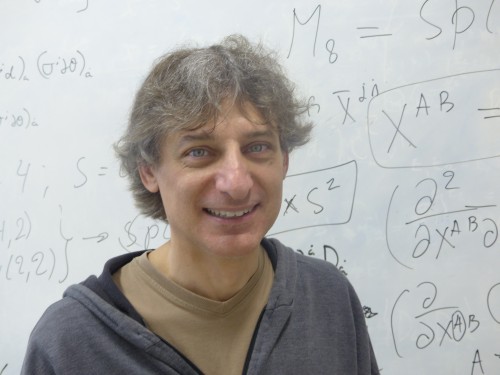
Happy days – Nathan Berkovits enjoying life at the new ICTP South American Institute for Fundamental Research.
By Matin Durrani in São Paulo
Today was the second day of the Physics World trip to Brazil and I flew from Rio de Janeiro down the coast to São Paulo, which is about an hour’s flight away. After yesterday’s disappointingly poor weather in Rio, things aren’t any better further south – in fact, it’s probably raining even more heavily today.
São Paulo is the largest urban area in South America, as becomes obvious from the forest of tower blocks that you skirt over on approaching the city’s downtown airport.
But the city is also, according to US-born string theorist Nathan Berkovits, an enjoyable place to live. In fact, Berkovits has an extra reason to like the place – having worked at the São Paulo State University (UNESP) for almost two decades, he was last year appointed acting director of a new theoretical-physics institute that’s already one of the leading places of its kind in South America.
Going under the rather convoluted name of the International Centre for Theoretical Physics South American Institute for Fundamental Research (ICTP-SAIFR), it is the first overseas offshot of the famous ICTP set up by the Pakistani Nobel-prize-winning physicist Abdus Salam in Trieste in 1964 to boost science in developing nations.
Setting up centres like this was one of Salam’s dreams and ICTP-SAFIR is the first example of what the great theorist, who died in 1996, had foreseen. As well as Berkovits – and some 20 professors working at UNESP plus a number of support staff – it now has nine new postdocs while the first of a further five permanent faculty members has already been recruited.
I talked to two of the postdocs – Riccardo Sturani from Italy and Gero von Gersdorff from Germany – and it quickly becomes clear that without initiatives like ICTP-SAIFR, top international researchers like them would for sure not be working in South America.
I’ll be saying more about the institute in the Physics World special report on physics in Brazil, due out next April, but in the meantime it’s time to check out that rain again.
As a life member of the Indian Association of Physics Teachers and a former member of the American Association of Physis Teachers (30 Years), I think that the new ictp-safir can survive and flourish if it is having a strong support of “all” teachers, starting from “high school” level and including physics as well as other subjects like geography, astronomy, mathematics and even biology. In fact, I entered physics education 35 years ago (and happily staying in it) after completing M.Sc. in Biochemistry because of the inspiration from Sir John Kendrew – the Father of Molecular Biology. Therefor I think that South American physicists / scientists should establish south American Association of Science Teachers AfAST. I would be happy in supporting it, contact me using (dvsathe@gmail.com) as and when needed.
It is good to have installed the ICTP-SAFIR for theoretical physics in Brazil as an offshoot of the Salam’s ICTP in Italy. However, as Salam always insisted, there have to be experimental institutes to complement this work. Let us hope that you look for such places, too, as you did in South Korea.